Apple:Insect and Mite Management
Apple:Insect and Mite Management
San Jose scale
Pest of 700 different species of fruits, shrubs and ornamental plants Pest is active from March to December. Passes winter black cap stage in tree bark.Biology
 Nymph: Female San Jose scales give birth to living young that emerge from under the edge of the scale covering. Each female gives birth to 200-400 nymphs. These tiny yellow crawlers wander in a random fashion until they find a suitable place to settle. Immediately upon settling, the crawlers insert their mouthparts into the host plant and begin feeding and secreting a white waxy material (white cap stage); eventually the waxy covering turns black and is known as the black cap stage. Later the covers turn various shades from gray to black.
Nymph: Female San Jose scales give birth to living young that emerge from under the edge of the scale covering. Each female gives birth to 200-400 nymphs. These tiny yellow crawlers wander in a random fashion until they find a suitable place to settle. Immediately upon settling, the crawlers insert their mouthparts into the host plant and begin feeding and secreting a white waxy material (white cap stage); eventually the waxy covering turns black and is known as the black cap stage. Later the covers turn various shades from gray to black.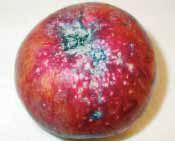 Adult: Immature male and female scales are indistinguishable until the fi rst molt. At this time, the male scale covering begins to elongate, while the females remain circular. Males molt a total of four times. Following the final molt, adult male scales emerge from the scale covering as tiny, yellow winged insects. They mate with the females who remain under the scale covering. Female insect body covered with grey scales. Yellow lemon coloured female is visible when covering is lifted. Female scales are very prolific and over a 6-week period can produce approximately 400 young. San Jose scale produce living young called crawlers; most other scales produce eggs. Crawlers move around for a short period in search of a suitable place to settle. It takes 25 days for males to mature and 31 days for females. Five to six generations in a year.
Adult: Immature male and female scales are indistinguishable until the fi rst molt. At this time, the male scale covering begins to elongate, while the females remain circular. Males molt a total of four times. Following the final molt, adult male scales emerge from the scale covering as tiny, yellow winged insects. They mate with the females who remain under the scale covering. Female insect body covered with grey scales. Yellow lemon coloured female is visible when covering is lifted. Female scales are very prolific and over a 6-week period can produce approximately 400 young. San Jose scale produce living young called crawlers; most other scales produce eggs. Crawlers move around for a short period in search of a suitable place to settle. It takes 25 days for males to mature and 31 days for females. Five to six generations in a year.Damage symptoms
- Nymph and female scales attack all above ground parts.
- Feeding site turns into a characteristic purplish red colour.
- Initially growth of plant is checked but as scale increases in number plant may die.
- Fruits will have distinct “measles” spots on the surface.
Woolly apple aphid
Biology
Native of Eastern United States First noticed in 1909 in Shimla on nursery stocks imported from England Reproduces parthenogenetically There is partial migration from aerial parts to the roots of infested plant in December. Reverse migration from root to aerial parts takes place in April and May.Eggs: The female laid a single, long, oval, cinnamon-colored egg almost as large as her body. The egg was laid in the crevices of bark.
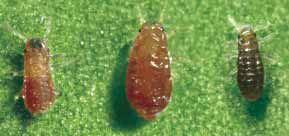
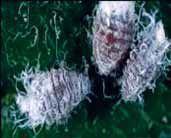 Nymphs: Eggs hatched in the spring into wingless, parthenogenetic, viviparous stem mothers. Nymphs hibernate underground on the roots of the tree. When elms were prevalent, eggs were usually laid in fall in the cracks or crevices of bark. These fed on elm buds and leaves for two generations during May and June, causing the elm leaves to curl into a rosette. They then produced a winged third generation that migrated to apple. After establishing new colonies the migrants produced repeated generations during the summer.
Nymphs: Eggs hatched in the spring into wingless, parthenogenetic, viviparous stem mothers. Nymphs hibernate underground on the roots of the tree. When elms were prevalent, eggs were usually laid in fall in the cracks or crevices of bark. These fed on elm buds and leaves for two generations during May and June, causing the elm leaves to curl into a rosette. They then produced a winged third generation that migrated to apple. After establishing new colonies the migrants produced repeated generations during the summer.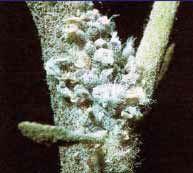
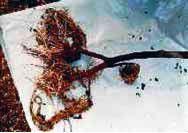 Adult: Adult and nymph reddish brown in colour. Covered with waxy filaments, they fed in wounds on the trunk and branches of the tree. In fall, winged aphids developed in both the aerial and the root colonies. They flew back to the elm, where they gave birth to males and females. Both males and females were wingless. Each female produces 116 young ones in her life. 13 generations a year.
Adult: Adult and nymph reddish brown in colour. Covered with waxy filaments, they fed in wounds on the trunk and branches of the tree. In fall, winged aphids developed in both the aerial and the root colonies. They flew back to the elm, where they gave birth to males and females. Both males and females were wingless. Each female produces 116 young ones in her life. 13 generations a year.Damage symptoms
- Nymphs and adults suck cell sap from bark of twigs and from underground parts.
- Underground feeding produces large knots on roots.
- Heavily infested plant have a short fibrous root system and yellowish foliage which can be easily uprooted.
European red mite
This mite occurs on many deciduous fruits but is most injurious to apple.Biology
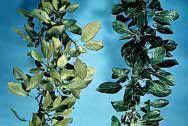 Egg: The European red mite overwinters as fertilized eggs. The environmental factors triggering winter egg production are diminishing food supply, temperature and photoperiod. The bulk of winter egg deposition occurs from mid to late August, but may continue until late September. Overwintering eggs are deposited in groups on roughened bark areas, especially around the base of buds and fruit spurs. These eggs may be so numerous that the infested areas take on a reddish cast. Egg hatch is closely correlated with bud development and first occurs when buds are in the tight cluster stage; hatch is better than 50% complete at the pink stage, and virtually 100% complete by the end of bloom. The first summer eggs as a rule can be found at petal fall or at latest by fruit set.
Egg: The European red mite overwinters as fertilized eggs. The environmental factors triggering winter egg production are diminishing food supply, temperature and photoperiod. The bulk of winter egg deposition occurs from mid to late August, but may continue until late September. Overwintering eggs are deposited in groups on roughened bark areas, especially around the base of buds and fruit spurs. These eggs may be so numerous that the infested areas take on a reddish cast. Egg hatch is closely correlated with bud development and first occurs when buds are in the tight cluster stage; hatch is better than 50% complete at the pink stage, and virtually 100% complete by the end of bloom. The first summer eggs as a rule can be found at petal fall or at latest by fruit set.The summer eggs are globular and somewhat flattened (onion shaped. They are bright red to dark orange and average 0.13 mm in diameter. The overwintering egg is deeper red and slightly larger, averaging 0.14 mm. The egg surface is ridged with the grooves running toward the top center from which a slender tapering stalk (0.1 mm) arises. The average incubation period of the summer eggs for each generation varies from 6.7 to 14.4 days, the shortest period being in mid-summer.
Nymph: The European red mite passes through 3 stages between egg hatch and adulthood. They are called the larva, protonymph and deutonymph. A quiescent or resting period precedes each molt to the following stage. The hatching larva is about 0.2 mm in length, light orange in color and 6 legged. All subsequent stages have 8 legs. With the exceptions of an increase in size and the ability to differentiate sexes in the deutonymphal stage, there are no conspicuous changes in structure or color between the nymphal instars. The average developmental time from eclosion to adulthood ranges from 5.5-15 days, depending on the generation.
Adult: There are 4-9 generations of the European red mite a year, depending on the locality and the length of the growing season. The sexes of the adults are readily differentiated. The female has a globular body which ranges in length from 0.38 to 0.40 mm, is velvety brown to brick red, and has 4 rows of dorsal setae or spines borne on raised white tubercles. The body color and setal pattern distinguish this species from all other plant feeding mites. The male is smaller, 0.26-0.28 mm in length, lighter in color and has a pointed abdomen and proportionately longer legs.
The rate of development is temperature dependent, being slower in the spring and fall and more rapid during the hot summer months. The first generation generally requires about 3 weeks developing, while summer generations may develop in 10 to 14 days. Reproduction can be both sexual and parthenogenetic. Unfertilized eggs give rise to males only, while mated females produce both sexes. The average preoviposition period of females is about 2 1/2 days. Although some females in insectary studies have lived 39 days, the average life span is 18 days. The oviposition period averages 12.5 days with 18.8 eggs produced per female.
Damage symptoms
- European red mite feeds on leaves.
- Severe mite injury produces browning and loss of colour in the leaves i.e. bronzing.
Codling moth
The rate of development will vary with temperature, proceeding more rapidly in warmer weather and climates. Depending on the climate, codling moth can have two, three, and sometimes four generations per year.Biology
 Egg: Eggs are deposited singly on apples and leaves. Each egg is about the size of a pin head and is translucent, gradually darkening as the egg nears hatching (Figure 6). Eggs hatch in six to 14 days, depending on temperature. Within 24 hours of hatching the larvae burrow into the fruit. The first instar larvae have a pink body with a black head and are approximately 1/10 inch in length. The number of eggs laid per female ranges from 30 to 70.
Egg: Eggs are deposited singly on apples and leaves. Each egg is about the size of a pin head and is translucent, gradually darkening as the egg nears hatching (Figure 6). Eggs hatch in six to 14 days, depending on temperature. Within 24 hours of hatching the larvae burrow into the fruit. The first instar larvae have a pink body with a black head and are approximately 1/10 inch in length. The number of eggs laid per female ranges from 30 to 70.Larva: After the eggs hatch, young larvae seek out and bore into fruit or developing nuts. Codling moth overwinters as full-grown larvae within thick, silken cocoons under loose scales of bark and in soil or debris around the base of the tree. Larvae appear to be cannibalistics. Full grown larva pinkish or creamy white with brown head and pupates in the soil litter.
Pupa: After completing development they leave the fruit and drop from the trees to search out pupation sites and continue the life cycle in the soil or on debris under the tree; some crawl back up the tree to pupate in bark crevices. The larvae pupate inside their cocoons in early spring and emerge as adult moths’ mid-March to early April. The moths are active only a few hours before and after sunset, and they mate when sunset temperatures exceed 62°F.
Adult: Adults are about 1/2 to 3/4 inch long with mottled gray wings that they hold tentlike over their bodies. Their appearance blends well with most tree bark, making them difficult to detect. If you are trapping the adults, you can distinguish codling moth from other moths by the dark, coppery brown band at the tip of their wings.
Adult forewings are dark grayish with waxy lines with a copper colored eye like circle toward margin.
Damage symptoms
- It is a direct pest and hence causes severe damage to the fruit.
- Neonate larva enters the fruit through calyx and feeds on seed.
- Infested fruits lose their shape and fall prematurely.
- 30 to 70 per cent apple fruits are rendered unmarketable.
Apple root borer
Infests fruit and forest trees. Apple is the most preferred host. Adults attracted to lightBiology
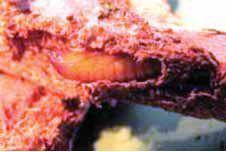
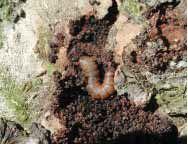 Egg: Female lays eggs singly or in small clusters in soil. Eggs are 1.3 mm in size. Newly laid eggs are white with a tinge of yellow and become dark brown before hatching.
Egg: Female lays eggs singly or in small clusters in soil. Eggs are 1.3 mm in size. Newly laid eggs are white with a tinge of yellow and become dark brown before hatching.Grub: Grubs feed on the root. Grub longevity 3.5 years. Grubs are eruciform, yellowish-white in colour and have 8–9 instars. Development period can be either 1 or 2 years. The exhibits 10 larval stages that develop over 20-21 months, with mature larvae almost reaching 80 mm in length and 12 mm in width.
Pupa: The pupae are about 48 mm long and usually found about 20–30 cm deep in the soil. Pupation inside earthen cell inside soil.
Adult: The adult beetle is chestnut red in color and bears long serrated antennae. Full grown grub is creamy white, 7.5-10 cm long.
Damage symptoms
- Grubs either bore or girdle around the roots.
- The leaves become small and the branches wither.
- Tree becomes shaky and may die.
Apple stem borer
Biology
Egg: Female lays egg inside cavity on a shoot. Eggs are very difficult to see and are laid singly on the trunk of the tree.Larva: Larvae of all three species are dirty white with a reddish-brown head and thoracic shield (area behind the head). Grub emerges in 7-8 days and start feeding by boring inside the stem. Grub longevity 2 years. Grub remains quiescent during winter and resumes feeding in March.
Pupa: Pupae are small, yellow-brown and sometimes observed as pupal cases partially protruding from the adult exit holes in the trunk or infested burr knots. Pupation takes place inside a tunnel made in the woody tissue.
Adult: Adult clearwing moths possess transparent wings with striking dark markings along the margins. Adult beetles 35-50 mm long and grey in colour having long antennae.
Damage symptoms
- Caused by grub and adult, grub more destructive
- Grub makes a tunnel and reaches close to trunk of tree.
- Vitality and productivity of plant is greatly impaired.
Indian gypsy moth
Biology
Egg: The egg mass is approximately 1.5 inches long and 0.75 inches wide. Eggs are attached to trees, houses, or any outdoor objects. The eggs hatch in spring (April) into caterpillars.Larva: They have five pairs of blue dots followed by six pairs of red dots lining the back. In addition, they are dark colored and covered with hairs. Young caterpillars primarily feed during the day whereas the older caterpillars feed at night. When present in large numbers, the older caterpillars feed day and night. Older caterpillars are approximately 1.5 to 2.0 inches long. Larval period 66-100 days.
Pupa: In early summer (June to early July), Gypsy moth caterpillars enter a pupal or transitional stage. The pupae are dark brown, shell-like cases approximately two inches long and covered with hairs. They are primarily located in sheltered areas such as tree bark crevices or leaf litter.
Adult: Adult Gypsy moths emerge from the pupae in 10 to 14 days. Females have white to cream-colored wings, a tan body, and a two-inch wingspan. Female Gypsy moths cannot fly. Females lay between 500 to 1,000 eggs in sheltered areas such as underneath the bark of trees. Both the adult female and male can be identified by the inverted V-shape that points to a dot on the wings. Gypsy moth has only one generation per year.
Damage symptoms
- Caterpillars are gregarious but voracious feeder.
- They eat voraciously on leaves at night time.
- Under heavy infestation entire leaf is eaten sparing only hard vein.
- Defoliation of host completely results in failure of fruit formation.
Blossom thrips
Biology
Egg: The eggs of thrips are deposited within plant tissues singly.Larva and pupa: Larvae have two stages, which feed on plant tissues. The second instar larvae, when mature, fall to ground, where they molt to prepupae and pupae in the soil.
Adult: After emergence, the adults move to the growing parts of the plants such as young leaves, flowers, or young fruits, where they feed and lay eggs (about 200 eggs per female). Adults are usually found on young leaves, while larvae are found on lower or older leaves. At 25°C, the life cycle is completed in approximately 17 days. Adults are winged sucking rasping insects ranging from 5-14 mm in length. Their slender bodies are shiny pale or black with silver stripes. Life cycle completed in 11-43 days. Produce many generations in a year heaviest damage occur in spring. In colder region, life cycle is longer with fewer generations
Damage symptoms
- The surface of the leaf develops a crinkled silvery appearance as a result of damage to cells below the surface.
- Lightly-infested plants show silvery feeding scars on the under surface of leaves, especially alongside the mid rib and veins.
- Heavily-infested plants show silvering and browning of leaves, stunting of young leaves and terminal growth, with fruit scarred and deformed.
- Developing leaves become distorced in the growing tips.
Tent caterpillar
Important pest of apple, in north western India being more serious in Shimla hills.Biology
Eggs: In late spring or early summer, female moth’s deposit an egg mass encircling small twigs or on tree trunks. Egg masses are present on trees during most of the summer, fall and winter. The adult moth uses a sticky, frothy substance called spumaline as an adhesive to attach eggs to bark or twigs. Spumaline also is used as a hard protective covering around the egg mass. Pest in active from March – May, passes 9 month of year in egg stage. Female lays the eggs in broad bands consisting of 200 to 400 eggs.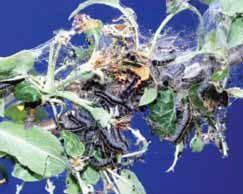 Larva: Caterpillars hatch from the eggs in early spring about the time host plants leaf out. The tent caterpillar feed on new leaves, forming small webs within a few days after hatching and enlarging the webs as they grow. The web or tent is most often in a crotch of small limbs, and serves as a refuge for the larvae during the night and during rainy spells. Larvae move from the tents to feed on leaves, so damage can be found for some distance around the web. Tent caterpillars feed in groups, and thus concentrate their defoliation. The tent caterpillars form conspicuous, large webs that are easily recognized. Molting, or skin shedding, occurs several times as the larvae grow. The larvae do not live in these small webs at other times. Caterpillar is progeny of a light reddish brown moth with two whitish stripes running across each of the forewings.
Larva: Caterpillars hatch from the eggs in early spring about the time host plants leaf out. The tent caterpillar feed on new leaves, forming small webs within a few days after hatching and enlarging the webs as they grow. The web or tent is most often in a crotch of small limbs, and serves as a refuge for the larvae during the night and during rainy spells. Larvae move from the tents to feed on leaves, so damage can be found for some distance around the web. Tent caterpillars feed in groups, and thus concentrate their defoliation. The tent caterpillars form conspicuous, large webs that are easily recognized. Molting, or skin shedding, occurs several times as the larvae grow. The larvae do not live in these small webs at other times. Caterpillar is progeny of a light reddish brown moth with two whitish stripes running across each of the forewings.Pupa: During the last stage of larval development, which occurs in late spring, larvae wander considerable distances and may feed on a variety of tree, shrubs and even herbs before finding a site for pupation, or cocoon spinning. Cocoons are formed in the web, under bark, in dead plant material on the ground, or inside a rolled leaf. Cocoons are loosely constructed of silk and have a white or yellowish crystalline substance scattered throughout the mass. Cocoons should not be handled since the crystalline substance may cause skin irritation, especially to people with allergies.
Adult: Adult tent caterpillars are brown and yellowish moths with two diagonal markings on the front wings. Their wingspread is about 1 inch. They are attracted to lights and can occasionally be very abundant. The moths live for only a few days, during which they mate and lay eggs. Adults do not feed. There is only one generation of tent caterpillars per year. Male are short lived and female may survive for 2 to 5 days.
Damage symptoms
- Caterpillars during the night rest at their nest and the day they feed on leaves.
- In severe infestation, the entire plant may be defoliated and subsequently the caterpillar may feed on bark of twigs.
- When severe infestation 40 -50 per cent plants in orchard may be defoliated producing a poor harvest.
Apple maggot
Apple maggots overwinter as pupae in the soil. Generally there is one generation a year, although there may be a partial second generation in warm years. Adults emerge in mid-June to early July; emergence usually peaks between mid- and late July and is over by late August.Biology
Egg: Females lay about 300 eggs over a 30-day life span. Female flies lay their eggs singly in apples and other fruits. This egg-laying activity begins in July and continues through early October. When laying each egg, the female makes a tiny puncture in the fruit and inserts the egg just below the skin. This initial fruit damage is easily overlooked, but eventually leads to fruit dimpling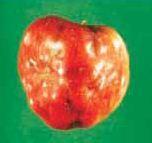
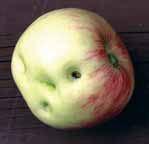 Maggot: Apple maggot eggs hatch in 3 to 7 days as small (less than 1/16 inch), cylindrical, cream coloured larvae known as maggots. Maggots lack legs and visible head capsules, but have dark mouth hooks that protrude from tapered heads. As apple maggots tunnel through the apple flesh, they leave characteristic winding brown trails that are best seen when the fruit is cut open. The first indication that a backyard apple tree is infested with apple maggot occurs when the homeowner discovers these brown trails in fruit at harvest. The maggots measure ¼ inch long when fully mature. Fruit damaged by apple maggot becomes soft, rotten, and often drops from the tree. They feed within the apple and pass through three instars before completing developing in 20 - 30 days. Maggots are carrot shaped, white and legless.
Maggot: Apple maggot eggs hatch in 3 to 7 days as small (less than 1/16 inch), cylindrical, cream coloured larvae known as maggots. Maggots lack legs and visible head capsules, but have dark mouth hooks that protrude from tapered heads. As apple maggots tunnel through the apple flesh, they leave characteristic winding brown trails that are best seen when the fruit is cut open. The first indication that a backyard apple tree is infested with apple maggot occurs when the homeowner discovers these brown trails in fruit at harvest. The maggots measure ¼ inch long when fully mature. Fruit damaged by apple maggot becomes soft, rotten, and often drops from the tree. They feed within the apple and pass through three instars before completing developing in 20 - 30 days. Maggots are carrot shaped, white and legless.Pupa: The apple maggot has one generation per year. Infested fruit fall to the ground; larvae leave the fruit, burrow into the soil, and molt into a fourth instar and then into a pupal stage to overwinter in the soil under the infested tree.
Adult: In early summer, apple maggot flies emerge from the soil and forage in the host tree canopy. There they feed on honeydew, bird droppings, and other sticky, sugary substances. An apple maggot flies measures 1/4 inch long. It has a black body, dark red eyes, black and creamy-white striped abdomen and a white spot on the thorax between the pair of transparent wings.
The black banding pattern on the wings is a key character to distinguish apple maggot from other fruit flies. The one exception is a snowberry maggot that feeds on snowberry bushes, but not on apples. Experts rely on microscopic examination to distinguish the apple maggot fly from the adult fly of the snowberry maggot.
Damage symptoms
- Caused by maggots.
- Maggots are called “railroad” because they leaves brown winding trail just under fruit skin.
- Burrowing of maggot sometime reduce apple to a brown rotten mass.
- Premature fall of infested fruits.
IPM for Apple
To know the IPM practices for Apple, click here.
Source: NIPHM, and Directorate of Plant Protection, Quarantine & Storage
Last Modified : 2/12/2020
© C–DAC.All content appearing on the vikaspedia portal is through collaborative effort of vikaspedia and its partners.We encourage you to use and share the content in a respectful and fair manner. Please leave all source links intact and adhere to applicable copyright and intellectual property guidelines and laws.
RELATED ITEMS
Apricot Insect Pests
This topic provides information about Apricot- In...
Nutritional / Physiological Disorders of Apple
This topic covers the information related to Nutri...
Apple: Diseases and Symptoms
This topic covers the Information related to Disea...
Apple Pests
This topic covers the information related to Pest ...
